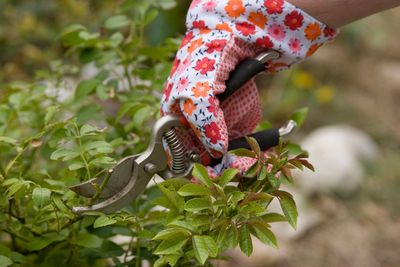Instructions for Pruning Roses
I am a “spring pruner” when it comes to pruning roses. Instead of pruning roses bushes way down in the fall after they have gone dormant, I wait until early spring when I see the leaf buds starting to form up well. My taller rose bushes do get a pruning down to about half their height once they have gone dormant in the fall. This fall rose pruning is to help prevent damage to the overall bush from winter winds and heavy snows, either whipping the canes around or breaking them over all the way down to the ground. Here in Colorado, and anywhere that gets winter long freezing weather, more often than not the spring pruning means cutting back roses down to within two to three inches (5 to 7.5 cm.) of the ground. Due to all the cane die-back from cold damage, this heavy rose pruning really is necessary for most of the rose bushes. I say most because there are a few exceptions to this heavy pruning. Those exceptions for trimming roses heavily are the climbers, most of the miniature and mini-floras as well as some of the shrub roses. You can find directions for pruning climbing roses here. The Hybrid Tea, Grandiflora, and Floribunda rose bushes all get the heavy rose pruning mentioned above. This means cutting the rose canes back to where green growth can be found, which is typically 2 to 3 inches (5 to 7.5 cm.) from the ground when the weather stays cold all winter. Very few years have allowed me to do what I would call a light pruning of cutting back the roses down to 6 or 8 inches (15 to 20.5 cm.) of the ground. In warmer zones, this heavy rose pruning would shock and horrify most rose gardeners. They would swear the rose bush has now most certainly been killed. In warmer areas, you may find that the dieback that needs to be pruned is only a few inches (5 to 12.5 cm.) into the rose bush. Regardless of the needed pruning, the rose bushes seem to take it all in stride. The new growth comes forth strong and proud, and before you know it they have regained their height, beautiful foliage, and amazing blooms. Keep in mind when pruning rose bushes that a slight angle to the cut is good to keep moisture from sitting on the cut end of the cane. Too steep a cut will provide a weak base for the new growth, so a slight angle is best. It is best to make the cut slightly angled, cutting 3/16 to 1/4 inch (0.5 cm.) above an outward-facing leaf bud. The leaf buds can be found at a location where an old multiple leaf junction to the cane formed last season.
Tips for Care After Cutting Back Roses
One very important step in this spring rose pruning process is to seal the cut ends of all canes 3/16 of an inch (0.5 cm.) in diameter and larger with some white Elmer’s glue. Not the school glue, as it seems to like to wash off in the spring rains. The glue on the cut ends of the canes forms a nice barrier that helps prevent cane boring insects from boring into the canes and causing damage to them. In some cases, a boring insect can bore down far enough to kill the entire cane and sometimes the rose bush. Once the rose pruning is all done, give each rose bush some rose food of your choice, working it into the soil a bit, and then water them well. The process of new growth leading to those cherished, beautiful blooms has now begun!
